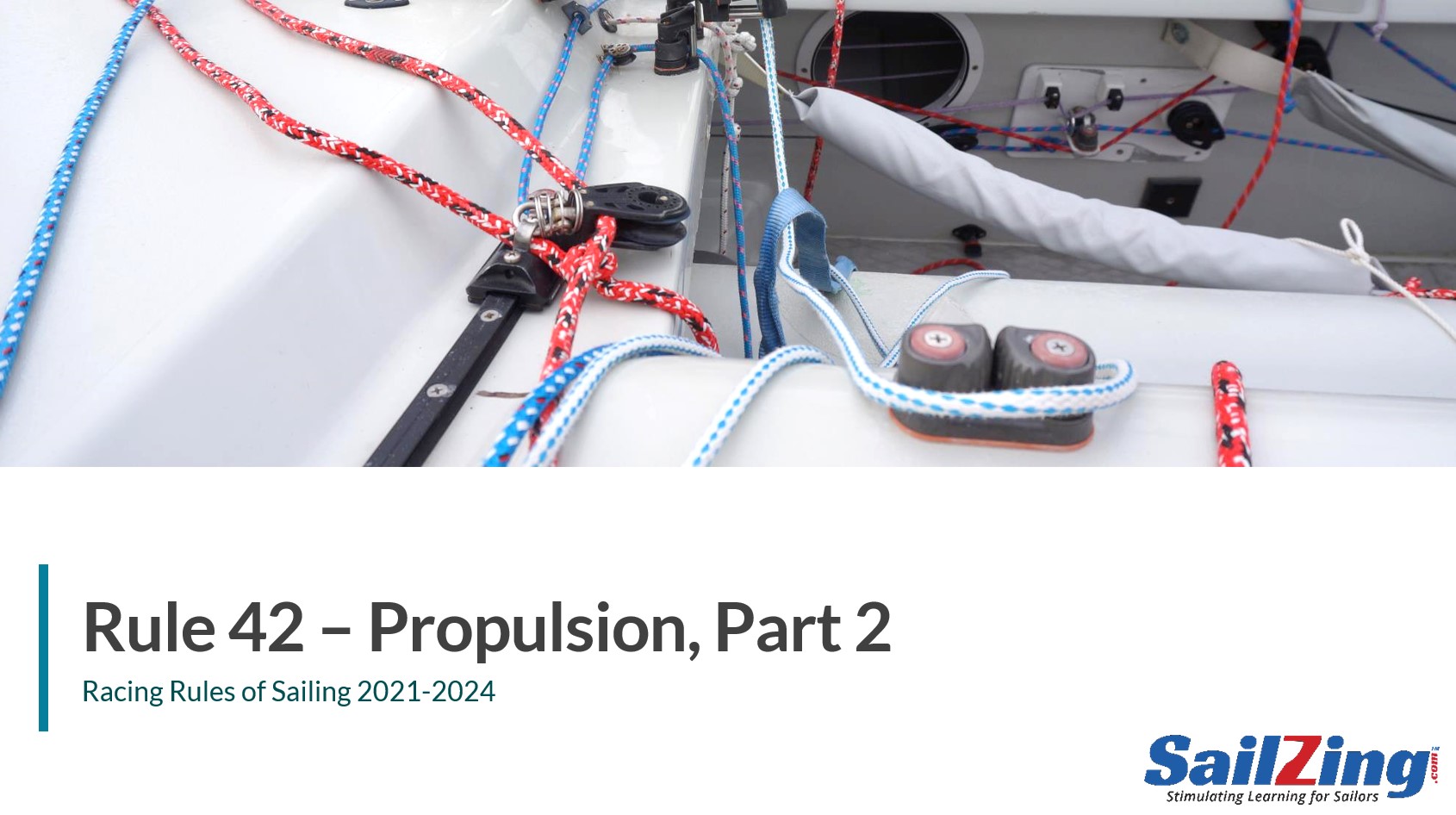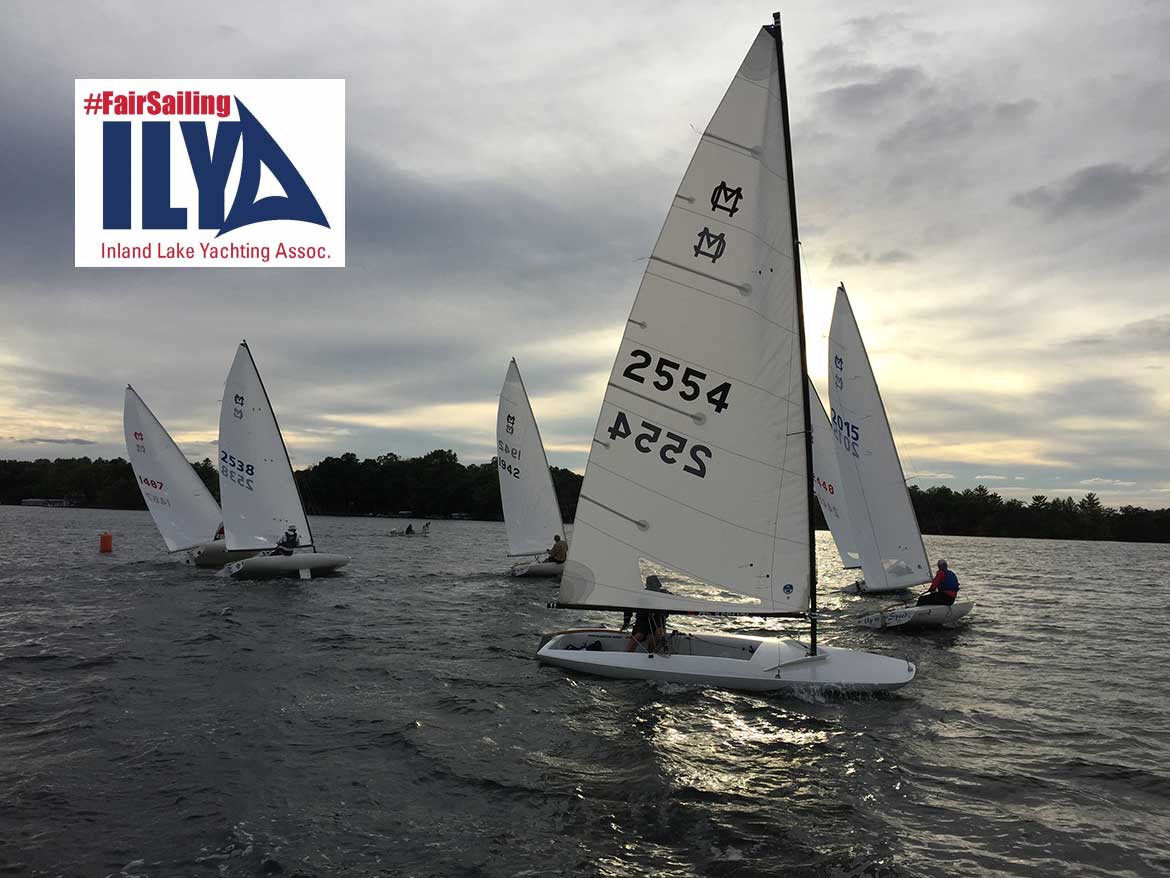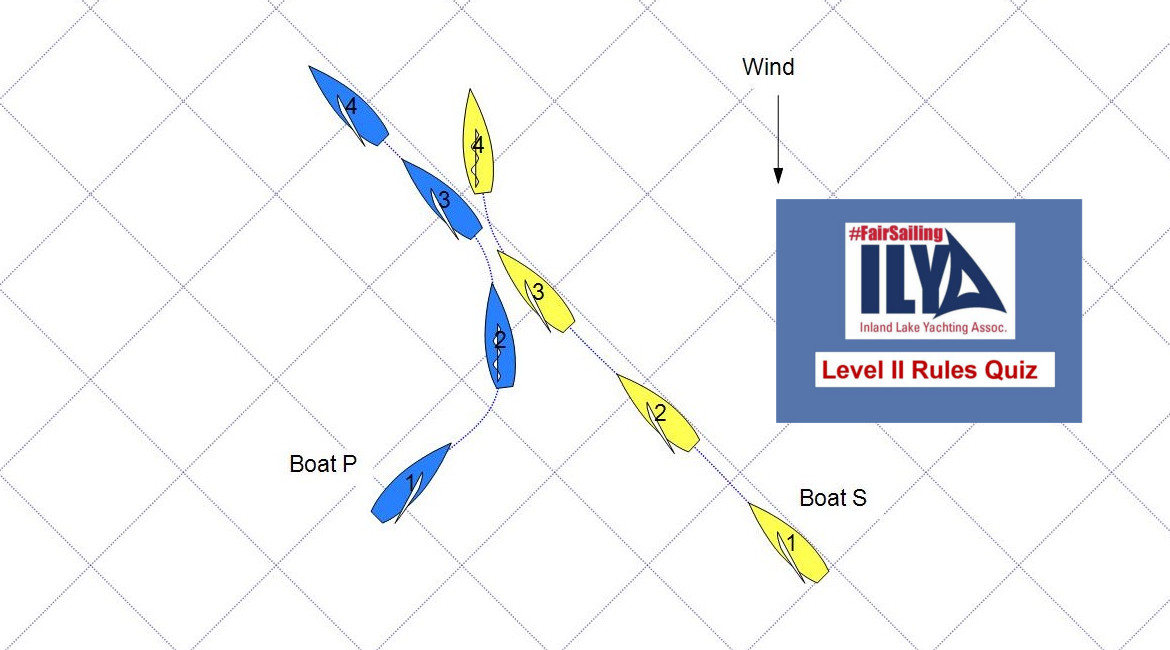Rule 42, Propulsion, addresses permitted and non-permitted ways to affect the boat’s speed while racing.
For this post, we assembled and organized all the available Rule 42 resources, including the rule, “official” interpretations, World Sailing cases, video examples, and commentary from several authors. See the related content section for a list of sources.
Because Rule 42 is complex, we’re presenting it in two parts. In part 1, we covered definitions and Rule 42.1 (basic rule) and 42.2 (prohibited actions). This post covers Rule 42.3 (exceptions).
To watch a video version of this post, click on the image below or go to our YouTube Channel.
Rule 42.3 – Exceptions
Rolling to Facilitate Steering
(a) A boat may be rolled to facilitate steering.
Notes and Interpretations
(Labels in caps are from Interpretations of Rule 42, Propulsion (May 2013))
- Heeling to windward to facilitate bearing away and heeling to leeward to facilitate heading up are permitted. The heeling of the boat has to be consistent with the boat’s turn. (ROCK 6)
- Repeated rolling not linked to wave patterns is rocking prohibited by rule 42.2(b), even if the boat changes course with each roll. (ROCK 7)
Video Examples
Rolling through a tack or gybe
(b) A boat’s crew may move their bodies to exaggerate the rolling that facilitates steering the boat through a tack or a gybe, provided that, just after the tack or gybe is completed, the boat’s speed is not greater than it would have been in the absence of the tack or gybe.
Notes and Interpretations
- Body movements that exaggerate rolling and cause a boat to sail out of a tack or a gybe at the same speed as she had just before the maneuver are permitted. (ROCK 8)
- It is permitted to move the mast to windward of vertical at the completion of a tack or a gybe. (ROCK 9)
- After a tack when a boat is on her new close-hauled course, body movement clearly propelling the boat is prohibited under rule 42.1. (BASIC 6)
- When the speed of a boat clearly drops after she accelerates out of a tack or a gybe, and there is no obvious change of wind speed or direction, the exception in rule 42.3(b) does not apply and the boat breaks rule 42.1. (BASIC 7)
Video Examples
Pumping to Facilitate Surfing, Planing, or Foiling
(c) Except on a beat to windward, when surfing (rapidly accelerating down the front of a wave), planing or foiling is possible, the boat’s crew may pull in any sail in order
(1) to initiate surfing or planing, but each sail may be pulled in only once for each wave or gust of wind, or
(2) to initiate foiling, each sail may be pulled in any number of times.
Notes and Interpretations
- A pull of any sail made to attempt to surf or plane when surfing or planing conditions are marginal is permitted even if the attempt is not successful. (PUMP 7)
- If a boat repeats an unsuccessful attempt to plane or surf, she is in the yellow light area. A third consecutive unsuccessful attempt is prohibited. (PUMP 8)
- Each sail may be pulled at a different time, but only as permitted by rule 42.3(c). (PUMP 9)
- It is only necessary for surfing or planing conditions to exist at the position of a boat for her to be permitted to pull in the sail. (PUMP 10)
- Surfing or planing may be possible for some boats but not for others. This can be caused, for example, by local gusts or by waves from a motorboat. Also, lighter crews may be able surf or plane when heavier crews cannot. (PUMP 11)
- The exception in rule 42.3(c) does not apply to a boat that is already surfing or planing. (PUMP 12)
Video Examples
Sculling
(d) When a boat is above a close-hauled course and either stationary or moving slowly, she may scull to turn to a close-hauled course.
Notes and Interpretations
- Provided the boat’s course is above close-hauled and she clearly changes direction towards a close-hauled course, repeated forceful movements of the helm are permitted until the boat is on a close-hauled course. This action is permitted even if the boat gains speed. She may scull to turn to a close-hauled course on either tack. (SCULL 1)
- After a boat has sculled in one direction, further connected sculling to offset the first sculling action is prohibited. (SCULL 2)
- Sculling to offset steering of the boat caused by backing a sail is prohibited. (SCULL 3)
- Repeated helm movements to position a boat to gain speed on each of a series of waves generated by a passing vessel are not sculling unless they are forceful, and the increase in speed is the result of a permitted use of the water to increase speed. (Casebook – CASE 8)
Video Examples
Other Exceptions
(e) If a batten is inverted, the boat’s crew may pump the sail until the batten is no longer inverted. This action is not permitted if it clearly propels the boat.
(f) A boat may reduce speed by repeatedly moving her helm.
(g) Any means of propulsion may be used to help a person or another vessel in danger.
(h) To get clear after grounding or colliding with a vessel or object, a boat may use force applied by her crew or the crew of the other vessel and any equipment other than a propulsion engine. However, the use of an engine may be permitted by rule 42.3(i).
(i) Sailing instructions may, in stated circumstances, permit propulsion using an engine or any other method, provided the boat does not gain a significant advantage in the race.
Related Content
Rule 42 – Propulsion: Part 1 of 2 SailZing.com
Interpretations of Rule 42, Propulsion (May 2013) – World Sailing
World Sailing Casebook
Video – Top 5 Rule 42 Mistakes and how to avoid them in Single-Handed Dinghy Racing – RYA
Video – Common Breaches of Rule 42 – Finn Class
Understanding Rule 42 – AeroNautic
Rule 42 Downwind Sailing Explained – ISA
Rule 42 Most Common Breaches: Laser Standard, Laser Radial and Laser 4.7 – ISA
Guidelines for on-the-water Rule 42 Enforcement at ICSA Events
RRS | World Sailing Judges Manual
100 Best Racing Rules Quizzes – Dave Perry – Quizzes 54-59
SailZing Racing Rules Posts





